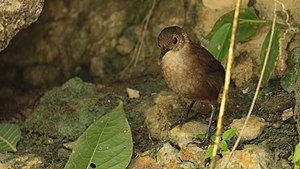Navaz Wren
| Navaz Wren | ||||||||||||
|---|---|---|---|---|---|---|---|---|---|---|---|---|

Navaz Wren ( Hylorchilus navai ) |
||||||||||||
| Systematics | ||||||||||||
|
||||||||||||
| Scientific name | ||||||||||||
| Hylorchilus navai | ||||||||||||
| Crossin & Ely , 1973 |
The Navazaunkönig ( Hylorchilus Navai ) is a bird art from the family of wrens (Troglodytidae), which in Mexico is endemic is. The stock is on the IUCN as endangered ( Vulnerable estimated). The species is monotypical .
features
The Navazaunig reaches a body length of about 16.0 cm, whereby the females weigh about 29.3 g. He has a tan face and greyish reins . The top of the head and the top are dark and gorgeous brown. The wing feathers are faintly blackish streaked. The throat and the upper chest area are whitish, which in the lower chest area merges into the grayish with an inconspicuous arched pattern. The flanks are sooty brown, the rump dark gray-brown. The eyes are brown, the bill blackish with a light orange-yellow base on the lower bill. The legs are dark gray. Both sexes are similar.
Behavior and nutrition
The Navazaun king presumably feeds on invertebrates. However, there are no reliable data on his eating habits. He looks for his food on rocky ground and in crevices.
Vocalizations
The singing of the Navazaun king is a varied, often bumpy warble of melodic whistles, which occasionally begins with a few weak, accelerating, gentle tones and ends in strong, uplifting tones. The singing is very different from the narrow- billed wren ( Hylorchilus sumichrasti ), so none of the other species respond to the sounds of recordings of the other species. The female's singing is described as an introductory tone followed by a series of eight or more loud whistles that give her an aura of indifference. It is not well coordinated with the male's song, unlike many tropical wrens . Mostly it overlaps with the male's song, but starts almost at the same time. The middle part and the end seem a bit random. It emits a metallic tink tone that is very different from the sounds of its conspecific conspecifics.
Reproduction
The breeding biology of the navy wren has not yet been researched or there are no reliable data.
distribution and habitat
The Navazaunig occurs on rocky outcrops of karst limestone. Here it moves at altitudes of 75 to 800 meters. In contrast to the narrow-billed wren, it seems to need undisturbed forest. There is no evidence that it is also in secondary vegetation.
migration
The naval wren is considered to be a resident bird .
Etymology and history of research
The Navazaunig was first described in 1973 by Richard Stanley Crossin and Charles Adelbert Ely under the scientific name of Hylorchilus sumichrasti navai . The type specimen was collected by Juan Nava Solorio (1923-2004) near Municipio Ocozocoautla de Espinosa . As early as 1897, Edward William Nelson introduced the Hylorchilus genus for the narrow- billed wren, which was new to science . This name is derived from "hylē ὑλη " for "forest, forest" and "orkhilos ορχιλος " for "wren". The species name »navai« is dedicated to its collector.
literature
- Donald Eugene Kroodsma, David Brewer in: Josep del Hoyo , Andrew Elliott, Jordi Sargatal , David Andrew Christie , Eduardo de Juana: Nava's Wren (Hylorchilus navai) in Handbook of the Birds of the World Alive . Lynx Edicions, Barcelona.
- James A. Jobling: Helm Dictionary of Scientific Bird Names . Christopher Helm, London 2010, ISBN 978-1-4081-2501-4 .
- Richard Stanley Crossin, Charles Adelbert Ely: A New Race of Sumichrast's Wren from Chiapas, Mexico . In: The Condor . tape 75 , no. 2 , 1973, p. 137–139 ( sora.unm.edu [PDF; 411 kB ]).
- Edward William Nelson: Preliminary Descriptions of New Birds from Mexico and Guatemala in the Collection of the United States Department of Agriculture . In: The Auk . tape 14 , no. 1 , 1897, p. 42–76 ( sora.unm.edu [PDF; 1.5 MB ]).
Web links
- Hylorchilus navai inthe IUCN Red List of Threatened Species 2019.3. Listed by: BirdLife International, 2018. Retrieved February 20, 2020.
- BirdLife International: Species Factsheet - Nava's Wren ( Hylorchilus navai ) . Retrieved February 20, 2020.
- Videos, photos and sound recordings of Nava's Wren (Hylorchilus navai) in the Internet Bird Collection
- Navazaunig ( Hylorchilus navai ) at Avibase; accessed on February 20, 2020.
- Hylorchilus navai in the Integrated Taxonomic Information System (ITIS). Retrieved February 20, 2020.
- xeno-canto: Sound recordings - Navazaunig ( Hylorchilus navai )
- Nava's Wren (Hylorchilus navai) in the Encyclopedia of Life . Retrieved February 20, 2020.